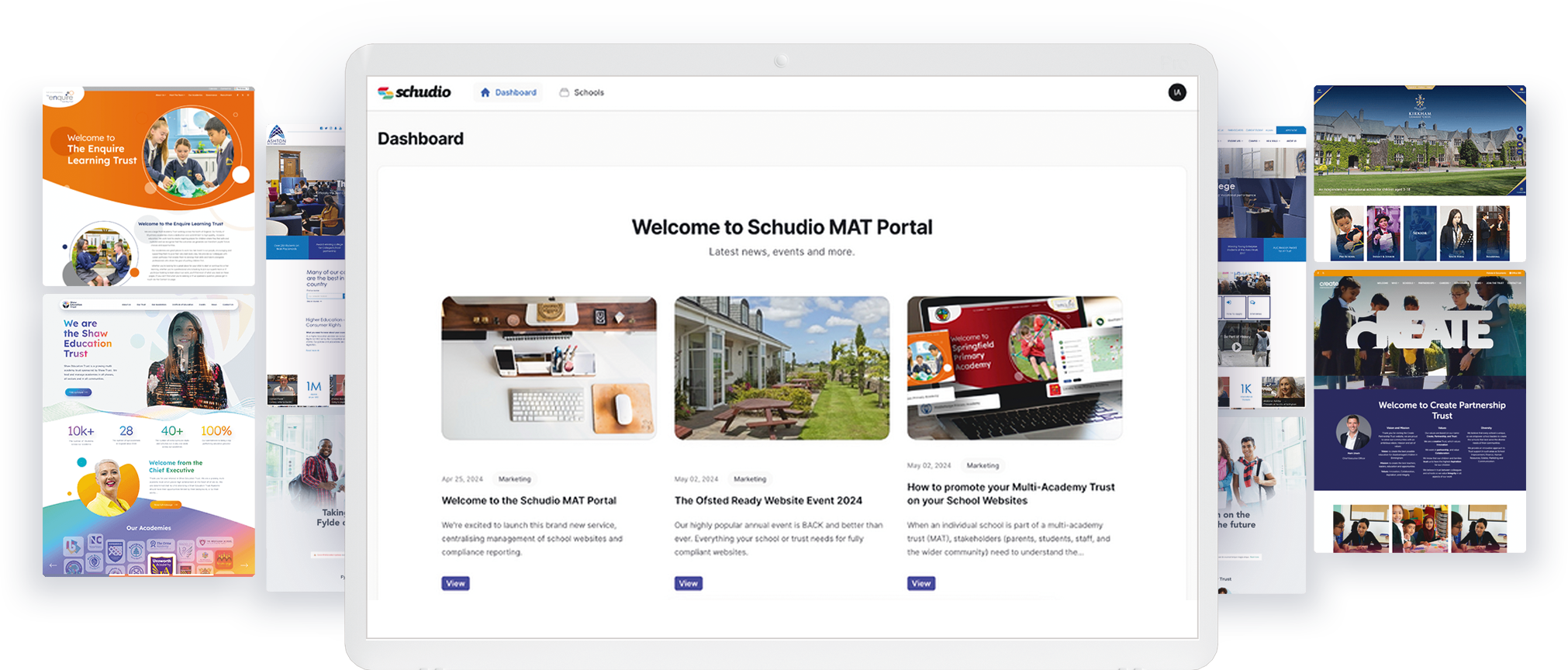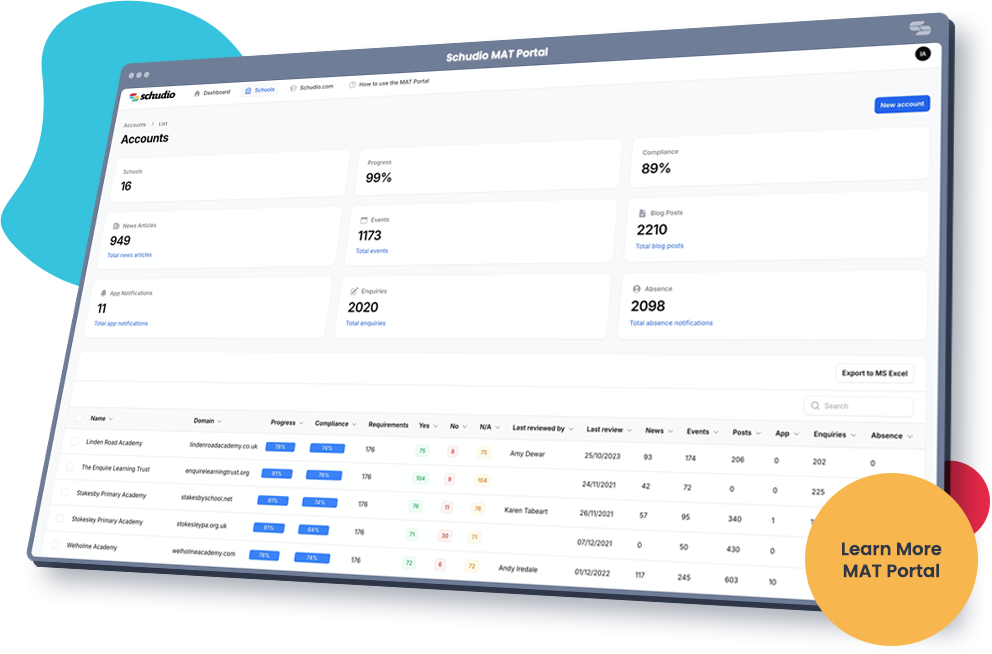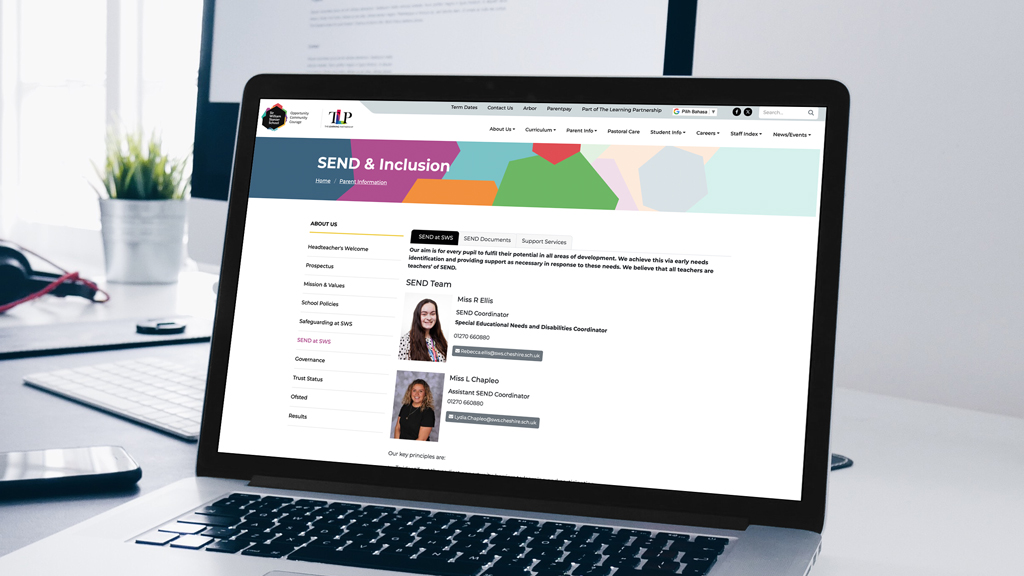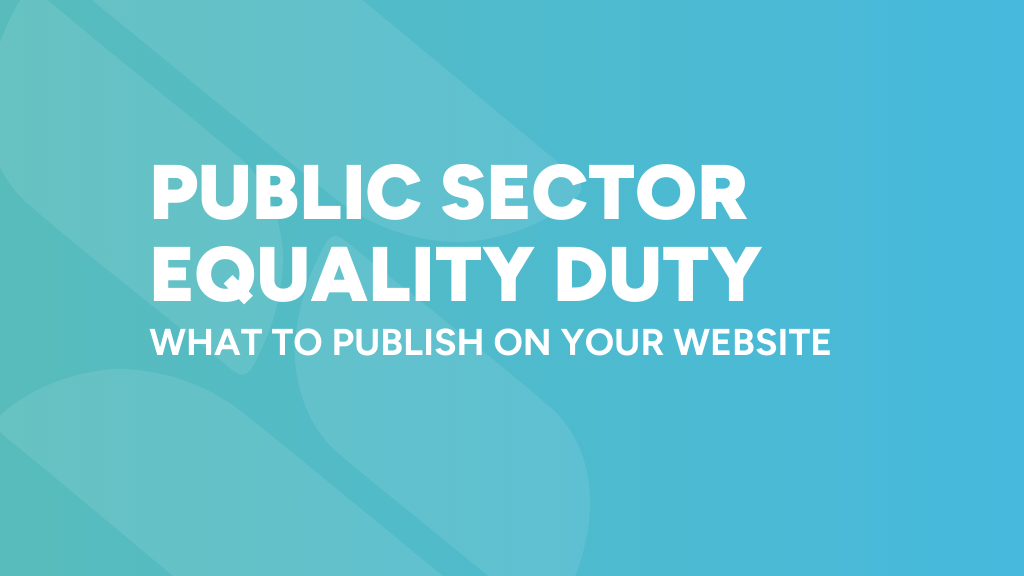Schudio MAT Portal: Product Overview for Multi Academy Trust Website Compliance
Schudio MAT Portal: Product Overview for Multi Academy Trust Website Compliance

Introduction to Schudio MAT Portal
The Schudio MAT Portal is a comprehensive platform specifically crafted to empower Multi Academy Trusts (MATs) in managing their websites while ensuring compliance with statutory requirements. For MATs, maintaining a robust online presence is crucial to providing easy access to information for parents, pupils, and the wider community. This includes meeting obligations such as publishing the annual report and audited financial statements by specified deadlines.
The Schudio MAT Portal offers a suite of features and tools designed to help MATs create and sustain websites that fulfill stakeholder needs. With a strong emphasis on compliance, the portal facilitates the online publication of governance arrangements, admission arrangements, and other pertinent information. Additionally, it is vital to disclose ‘material interests arising’ from close family relationships among trust leaders and governance members, thereby enhancing transparency and communication across the Trust.
Academy Trust Compliance Essentials
Academy trusts are required to adhere to statutory requirements for their trust website, including the publication of specific information online. The trust website is a vital resource for the school community, and it is essential to ensure compliance with the latest guidance. The Department for Education (DfE) outlines what information should be published on academy websites, including admission arrangements, financial reporting, and executive pay. This section provides an overview of compliance requirements for academy trusts, encompassing the funding agreement, school admissions code, and statutory guidance.
Compliance Overview
The compliance overview for academy trusts involves ensuring that the trust website is current and adheres to the latest guidelines. This includes publishing information on admission arrangements, financial reporting, and executive pay. The trust must also ensure the website is readily accessible and user-friendly. The governing board holds responsibility for statutory compliance, while school staff are tasked with website maintenance. The trust must also have an online complaints procedure and publish details of this procedure. Furthermore, the trust must disclose information regarding the gender pay gap, key stage results, and special educational needs (SEN) information report.
Simplifying Multi Academy Trust Website Compliance
Centralise Compliance. Streamline Communication. Take Control Across Your Trust.
Offering a comprehensive compliance overview, we guide Multi Academy Trusts (MATs) in fulfilling their statutory website obligations, ensuring adherence to legal standards and best practices. For further information, parents and stakeholders are encouraged to contact the local authority on specific topics.
💡 Built for Multi-Academy Trusts Seeking Confidence and Clarity
Managing website compliance across a Multi Academy Trust is critical. Each academy website must meet DfE requirements. Admission authorities within academy trusts are responsible for admissions compliance and must publish their admissions arrangements on their websites as mandated by the school admissions code and governance handbook. Maintaining this information is crucial throughout the entire school year during which school placement offers are made.
The Schudio MAT Portal is specifically designed for Multi Academy Trusts, providing Trust leaders with a powerful, easy-to-use platform to oversee and manage every school website — covering compliance, analytics, policy publishing, and content.
Whether consolidating providers, enhancing visibility, or scaling with confidence — the MAT Portal puts you in control.
✅ Features and Benefits
✔️ Website Compliance & Policy Management (Live)
Ensure every school in your Trust meets the latest DfE school website requirements by maintaining transparency regarding governing bodies.
Adhere to your funding agreement stipulations when publishing information on websites to ensure compliance and financial transparency. Additionally, ensure all mandatory reporting requirements include data from the previous academic year to meet regulatory standards.
Utilize a central dashboard to audit, track, and support each school’s website compliance.
Manage policies from ratification to publication — and deploy updates automatically across sites.
✔️ GDPR-Compliant Website Analytics (Live)
Access performance data across all school websites, free from cookies or privacy concerns. Publishing gender pay gap information is crucial for transparency measures, as mandated by the Equality Act 2010. Additionally, detailing executive pay, including salaries exceeding £100,000 and trustee remuneration, enhances financial transparency and compliance. Trust-wide, anonymised analytics provide visibility and confidence — with no extra setup required.
✔️ Content Deployment Across Schools (Live)
Create rich content once (e.g., curriculum updates, safeguarding pages, key policies). Academies receiving pupil premium funding are required to publish a strategy statement outlining their plans for utilizing these funds on their school website annually. Additionally, schools must publish specific information about their PE and sport premium funding, detailing how this funding will be spent and the intended impact on students’ educational attainment.
It is also crucial for academies to have accessibility plans that aim to enhance the participation of disabled pupils in the curriculum over time.
→ Publish instantly across all your school websites. → Avoid duplication, delays, or outdated pages.
🆕 Coming Soon
📰 Curate & Share Content
Manage Trust-wide news, photo galleries, and job vacancies in one place. Schools are required to publish the recent Ofsted report on their websites. Additionally, performance measures and other relevant information must be published for each academic year. Free schools, academies, and colleges must comply with legal regulations by updating their websites to reflect changes in requirements and provide comprehensive information that meets Department for Education guidelines. Push content to selected schools — or all — and maintain consistent updates across your Trust.
📄 Full Policy Lifecycle Management
From first draft to final publication — oversee and automate the full policy process centrally. Adhering to statutory guidance is crucial when managing policies to ensure compliance with legislative mandates. Additionally, disclosing material interests, especially those related to family relationships among governance leaders, is essential for maintaining transparency and mitigating potential conflicts of interest.
The local authority plays a significant role in managing in-year school admissions, requiring trusts to provide information about the coordination scheme when the local authority oversees these applications.
Easily ensure version control, scheduled review dates, and site-wide distribution.
Academy Trust Requirements
Academy trusts must publish specific information on their website, including admission arrangements, financial reporting, and executive pay. The trust must also publish information on the governing board, including the names of charity trustees and members. The trust must ensure that the website is compliant with the public sector equality duty and that the information is accessible to all users. The trust must also publish information on the catch-up premium, pupil premium funding, and sports premium. Furthermore, the trust must publish details of the trust’s governance arrangements, including the names of local governors and committee meetings.
Admission Arrangements
The admission arrangements for academy trusts must be published online, including the published admission number, admission authority, and appeal procedures. The trust must ensure that the admission arrangements are compliant with the school admissions code and that the information is easy to find. The trust must also publish information on the admission appeals process, including the timeline for appeals and the procedure for submitting appeal papers. Additionally, the trust must publish information on the admission authority’s decisions and the reasons for those decisions.
Financial Reporting and Executive Pay
The financial reporting requirements for academy trusts include publishing the annual accounts and executive pay information. The trust must ensure that the financial information is accurate and up-to-date and that the executive pay information is published in a readily accessible format. The trust must also publish information on the gross annual salary of employees and the names of employees who earn above a certain threshold. Furthermore, the trust must publish information on the trust’s financial management, including the budget and financial forecasts. The trust must also ensure that the financial information is compliant with the equality act and that the information is accessible to all users.
Governance and Management
Effective governance and management are crucial for the success of any MAT. The Schudio MAT Portal provides a range of tools and resources to support governing boards in their role. This includes features for managing board and committee meetings, tracking relevant business, and publishing details of governance arrangements online. By using the portal, MATs can ensure they are meeting their statutory requirements and providing transparency for their stakeholders. Additionally, the portal offers guidance on the public sector equality duty, helping MATs ensure they meet their obligations in this area. This comprehensive approach to governance and management supports MATs in maintaining high standards and fostering trust within their communities.
Education and Colleges
The Schudio MAT Portal is designed to support a range of educational institutions, including primary schools, secondary schools, and further education colleges. The portal provides a variety of features and tools to help these institutions manage their websites and ensure compliance with statutory requirements. This includes capabilities for publishing information about the curriculum, tracking educational achievement, and providing support for pupils with special educational needs. Maintained schools, in particular, have specific obligations to publish certain information online, and the governing boards must ensure these schools maintain updated and accessible websites. By using the portal, educational institutions can ensure they are meeting their statutory requirements and providing a high-quality education for all pupils. The Schudio MAT Portal helps schools and colleges maintain an effective online presence, supporting their mission to deliver excellent education and foster student success.
🎯 Why MAT Leaders Choose Schudio
- ✅ Total oversight without losing individual school identity
- ✅ Massive time savings for central and local teams
- ✅ Expert-driven compliance tools built in
- ✅ Works with any website provider
- ✅ Transparency measures including publishing information about charity trustees
- ✅ Financial transparency through the publication of annual accounts (Full content control when using Schudio websites across the Trust)
“We don’t worry about our websites anymore.” — David Hilton, Director of Curriculum & Standards, The Active Learning Trust.
👇 Ready to Take a Look?
Choose how you’d like to explore the MAT Portal:
Providing transparent contact details, such as those of the special educational needs co-ordinator and general communication channels, is essential for effective communication. Additionally, having a clear complaints procedure that complies with regulatory standards ensures that parents and guardians can easily address any concerns.
– Send us a quick message and we’ll get right back to you. – See the platform in action and ask your questions live.💬 Frequently Asked Questions
Does this work if our schools use different website providers? Yes – the MAT Portal is fully compatible. You’ll still access the compliance dashboard, analytics, and policy publishing tools across all sites.
Do we need Schudio websites to use the Portal fully? You’ll get the most benefit with Schudio websites (e.g., full content deployment), but many core features work independently.
What if we already have a compliance process? Great! The MAT Portal will complement and streamline it — with visual dashboards, automation tools, and expert support.
What information about remote education provisions must be published? Schools and academies are required to publish specific information about their remote education provisions. This includes guidance on expectations related to remote education and outlines what details must be shared with the public regarding the school’s remote learning strategies.
Why is it important to publish equality objectives? Publishing equality objectives is crucial for schools and colleges as part of their statutory and recommended content. This ensures transparency and promotes equality within their operations by disclosing specific information that educational institutions are required to share.
👋 Let’s Get Started
Explore how the Schudio MAT Portal can help your Trust:
- Achieve full Multi Academy Trust website compliance by ensuring that all required information is readily accessible on your school websites.
- Publish the following details to comply with legal regulations: admission arrangements, exclusion arrangements, and governance information, among others. Additionally, ensure that accessibility plans are in place to support which disabled pupils, increasing their participation in the curriculum.
- Free up your team’s time
- Communicate consistently across every school website











